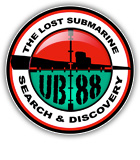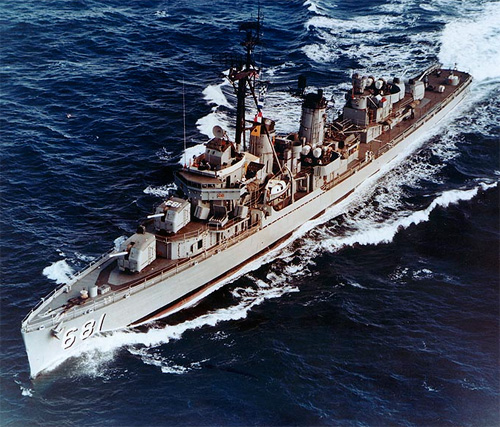
USS Hopewell underway during the 1960s. Navy photograph
NH 89658-KN
USS Hopewell (DD-681)
Fletcher Class Destroyer
Found off San Clemente Island
Dive Report
February 12, 2011
by Kendall Raine
Underwater photos by John Walker
Weather conditions were
perfect today as Capt. Ray Arntz, John Walker, Scott
Brooks and I left Huntington Beach aboard Sundiver II
bound for San Clemente Island. Our objective was to dive
a promising target which Gary Fabian's extensive research
of multibeam sonar data and Navy records indicates is the
USS Hopewell (DD 681) which was sunk February 11, 1972
during Walleye II missile testing.
Launched May 2, 1943, Hopewell was a Fletcher Class
destroyer which saw service in the Pacific in WW II,
Korea and Vietnam until decommissioned in 1970. Modified
between the wars, she had her twin quintuple torpedo
tubes and her number three aft mounted forward facing 5"
main armament removed. Other modifications included a
more robust mast to accommodate modern radar arrays.
Our dive plan was to do a single circumnavigation of the
wreck and limit our time to 10-15 minutes. Scott
volunteered to serve as support diver for us.
Surface conditions on site were flat seas, no wind,
bright sunshine. Clusters of sea lions lazed on their
backs with fins in the air as we approached the site. A
few energetic ones played with the float on the end of
the down line as we geared up.
We splashed and scootered over to the float. There was
about a half knot current running so we performed checks
quickly and dropped. Running at full speed and pitch, we
estimated our descent time would take roughly five
minutes. Side scan images taken at the time of the
original Vammen exploration suggested our target was
lying on its side with roughly 30 feet of relief.
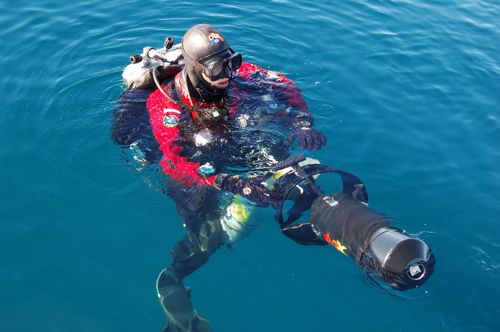
Kendall Raine
Photo by Capt. Ray Arntz
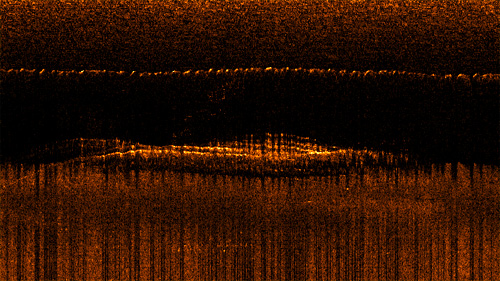
Side scan sonar image of USS Hopewell (DD-681)
Capt. Ray Arntz
John and I hit a thermocline at about 150' and the water
became colder, clearer and darker. At roughly 30 feet
above the wreck white and brown basket sponges came into
view. We came in on the starboard side roughly amidships.
As we leveled off at main deck level, John and I assumed
our usual formation with him flying behind me and inboard
of the starboard rail with me just outboard. I was
delighted to find the ship completely upright as this
would make for a more interesting site than if she were
on her side. As with the Burns and Vammen, Hopewell has
become a veritable garden with thousands of fish,
metridium, sponges and Corynactis covering every inch of
the hull.
I looked inboard and upward to see the two forward main
turrets with their barrels angled up. Against the cobalt
blue of the shallower depths, this was majestic. I soon
reached the bow. To my delight I found a basket sponge
perched at the bow chock just like that on the Vammen. I
rounded the bow and headed aft down the port side. No
sooner had I made the turn than the ships massive port
anchor came into view.
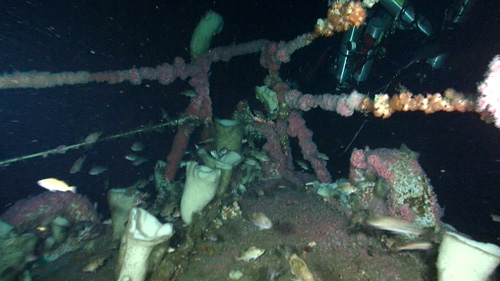
Large basket sponges on the bow of Hopewell
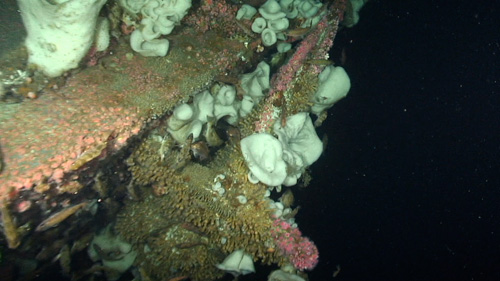
Port anchor
Like the rest of Hopewell, this was covered in violent
orange Corynactis. Looking inboard, I saw a hatch between
the two hawse pipes and ahead of the capstan. Peering
into this hatch I could see several decks down as timid
rockfish peered back from inside.
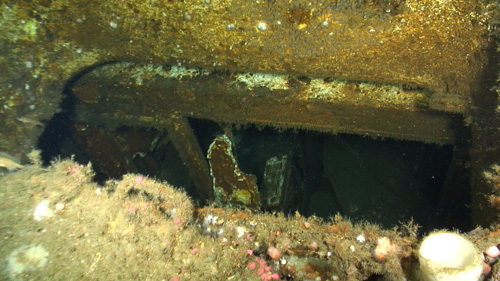
Bow hatch
I continued aft as John made the turn at the bow. I
admired the impressive main guns and then looked up to
see the angled bridge rising above the main deck. Just
ahead of me was the port side hedgehog and above that was
a row of intact portholes of the fighting bridge.
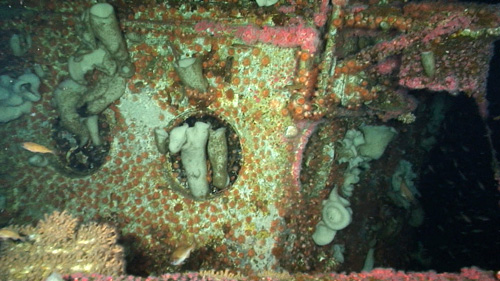
Portholes
I continued aft along the port rail and came across a
large pipe bent outward by some massive force. Photos of
the ship suggest this was railing on the second deck, now
bent forward by the explosion of the Walleye missile. I
maneuvered past this grating and found a massive hole in
the main deck where the twin stacks once stood. This was
obviously a missile impact area and the hole looked like
it went at least two decks down.
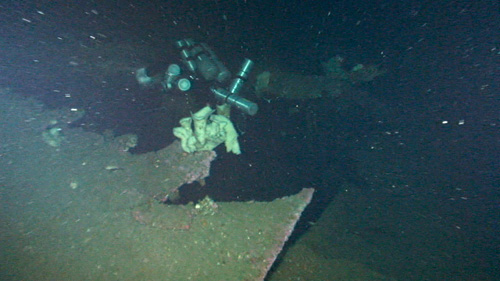
Missile impact zone
The size of the hole, perhaps 20 feet in diameter, was
mute testament to the massive power of the Walleye. I
briefly motored into this void and looked fore and aft to
see the total destruction inside. Points of access into
interior passageways were visible, but obstructive
wreckage was everywhere. I climbed up and out of the
impact hole as John joined up. We noted the two aft main
turrets appeared to have been removed and capped prior to
the ships sinking. Together we motored aft through clouds
of small fish only to be confronted by a steel wall where
none should be. Rising at an angle perhaps 15 feet, we
were seeing the fantail of the ship which had been thrust
upward by the massive power of the ships impact on the
ocean floor. I rolled over the side and the port screw,
completely covered in metridium and sponges came into
view. With its three blades and pointed hub, it looked
beautiful and threatening at the same time.
The transom looked strangely tapered and we rounded the
stern. It was even more richly covered with sponges. We
flew just over the starboard screw noticing the struts
and rudders and then up again to the main deck.
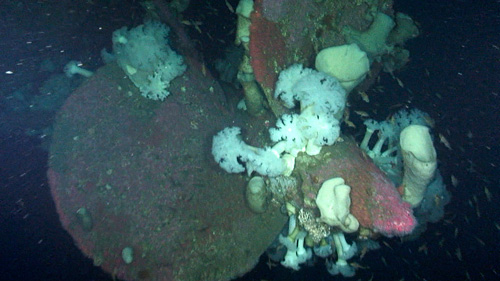
Propeller
As our allotted bottom time ended John and I began our
ascent. Because we had descended so far below the depth
limit of our bottom timers, the wreck was out of site by
the time we reacquired accurate depth information. We
continued up to our first stop at 250 and prepared for
the series of short deep stops and gas switches. At 150
we fired a bag and waited for Scott to come floating down
from Sundiver II with back-up gas and a bottle of Mezcal.
This he did right on time and John and I promptly loaded
him down with used deco bottles.
The curious sea lions who had entertained us on the
surface now joined us at the shallower stops and we
finished the long deco to emerge into a beautiful sunny
day.
As we motored up the island to meter the recently located
submarine, a pod of large Pacific Bottle Nose dolphins
joined us and leaped high in the air and riding our wake.
Joining in the fun were a half dozen sea lions who tried
gamely to keep up; jumping and twisting. It was almost as
if they were celebrating along with us. It was one of
those moments that lasted only a few minutes but stay
vivid in the mind's eye for many years.
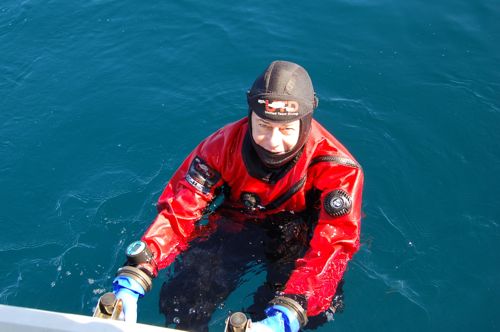
Johnny Walker. The man you seldom see because he's always
behind the camera.
Photo by Capt. Ray Arntz
Video by John Walker
USS Hopewell DD-681 from John Walker on Vimeo.
